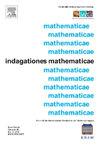一类二维随机游动的有限补偿过程
IF 0.5
4区 数学
Q3 MATHEMATICS
引用次数: 0
摘要
在排队应用的激励下,我们考虑了一类二维随机漫步,其不变测度可以写成有限个乘积项的线性组合。在这项工作中,我们研究了在哪些条件下可以通过应用有限补偿程序推导出这样一个优雅的解。根据内部区域的跃迁概率、边界和原点之间的关系来表述这些条件。文中还讨论了这些条件的重要性。本文章由计算机程序翻译,如有差异,请以英文原文为准。
A finite compensation procedure for a class of two-dimensional random walks
Motivated by queueing applications, we consider a class of two-dimensional random walks, the invariant measure of which can be written as a linear combination of a finite number of product-form terms. In this work, we investigate under which conditions such an elegant solution can be derived by applying a finite compensation procedure. The conditions are formulated in terms of relations among the transition probabilities in the inner area, the boundaries as well as the origin. A discussion on the importance of these conditions is also given.
求助全文
通过发布文献求助,成功后即可免费获取论文全文。
去求助
来源期刊
CiteScore
1.20
自引率
16.70%
发文量
74
审稿时长
79 days
期刊介绍:
Indagationes Mathematicae is a peer-reviewed international journal for the Mathematical Sciences of the Royal Dutch Mathematical Society. The journal aims at the publication of original mathematical research papers of high quality and of interest to a large segment of the mathematics community. The journal also welcomes the submission of review papers of high quality.

 求助内容:
求助内容: 应助结果提醒方式:
应助结果提醒方式:


